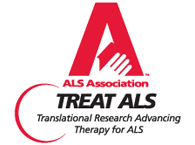What is ALS?Amyotrophic lateral sclerosis (ALS), often referred to as Lou Gehrig’s disease in the USA and Motor Neuron Disease (MND) in the UK, is a progressive neurodegenerative disease that affects nerve cells in the brain and the spinal cord. When the motor neurons die, the ability of the brain to initiate and control muscle movement is lost. The progressive degeneration of the motor neurons eventually leads to a patient’s death. With voluntary muscle action progressively affected, patients in the later stages of the disease may become totally paralyzed. Every 90 minutes, someone receives an ALS diagnosis. Every 90 minutes, someone dies from ALS.
The onset of ALS is insidious with muscle weakness or stiffness as early symptoms. Progression of weakness, wasting and paralysis of the muscles of the limbs and trunk as well as those that control vital functions such as speech, swallowing and later breathing generally follows, It is estimated that ALS is responsible for nearly 2 deaths per 100 K population annually, Approximately 5,600 people in the U.S. are diagnosed with ALS each year. The incidence of ALS is two per 100,000 people, and it is estimated that as many as 30,000 Americans may have the disease at any given time, Although the life expectancy of an ALS patient averages about 2 to 5 years from the time of diagnosis, this disease is variable and many people live with quality for five years and more. More than half of all patients live more than 3 years after diagnosis, About 20 % of people with ALS live 5 years or more and up to 10 % will survive more than 10 years and 5 % will live 20 years. There are people in whom ALS has stopped progressing and a small number of people in whom the symptoms of ALS reversed.
skip to main |
skip to sidebar


1951 - 2009

Facebook Badge
Pages
Science without religion is lame,
Religion without science is Blind.
Albert Einstein
 Subscribe Feed
Subscribe Feed

The Way We See It
Religion without science is Blind.
Albert Einstein
The Way We See It
We really don't know the final outcome of our efforts, we may not be around for it, but we will definitely have been a part of it.
Broadcast Group
| ALSforums is a volunteer moderated online support group for anyone directly or indirectly affected by ALS/MND. USA,UK,CAN | |
| Friends that help...Join now! | |
Michael Goldsmith Remembered

1951 - 2009
Labels
- ALS (60)
- ALS Advocate (141)
- ALS Association (17)
- ALS Awareness (99)
- ALS Awareness Day (20)
- ALS clinical trial (12)
- ALS Funding (26)
- ALS healthcare professionals (8)
- ALS military (25)
- ALS Registry (52)
- ALS research (43)
- ALS TDI (1)
- ALS Veterans (3)
- ALSA (1)
- Canada health care (1)
- Christianity (2)
- Faith (2)
- Familial ALS (4)
- Governor (1)
- Jane Gilbert (1)
- Kennedy Space Center (1)
- Leo Greene (1)
- Lou Gehrigs Disease (16)
- MDA (1)
- Medicare (3)
- MLB (4)
- Patrick O'Brien (2)
- Stem Cell Research (13)
- VA (2)







